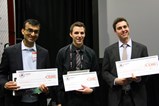Surface Inspection, BNP Testing, And Remote Image-Guided Surgery Top Startup Challenge

By Ron Grunsby, editor
A saying I heard several times last week at SPIE Photonics West was, “For every chicken getting swallowed, there’s an egg hatching.” This refers to the fact that although companies are often acquired in the photonics industry, and consolidation is a concern, there are always a number of startups beginning their own journey.
Ten such “eggs” competed for $17,500 last Wednesday at the 3rd Annual SPIE Startup Challenge for photonics technology, sponsored by Jenoptik. The first-place, $10,000 prize went to 8tree co-founders Arun Chhabra and Erik Klaas for fastCHECK – a 3D surface inspection system that combines augmented reality techniques to deliver instant analysis. It is designed to address the chronic problem of fastener flushness in the aerospace industry.
Commercial aircraft are typically held together by about 60,000 rivets, and it’s important to make sure they are flush. If not, problems may range from fuel inefficiency to catastrophic failure due to structural integrity loss. According to Chhabra, this represents a big QA issue for the aerospace industry, where approximately $1 million is spent on rework for every new aircraft that experiences this problem. Current solutions range from manual techniques that are very time-consuming to automated approaches that lack repeatable reliability of results and are subject to interpretation.
“With fastCHECK, we project the scan results in real time back onto the aircraft surface,” Chhabra said. “It’s instant analysis, and we deliver a scan-to-actionable result metric of 1.8 seconds. This number allows the technician on the line the ability in real time to self-correct their work, boosting manufacturing efficiency. Second, it’s orders of magnitude faster than existing techniques that typically take hours, days, and sometimes even longer simply to interpret the scan data before truly making it actionable.” After winning the challenge, Chhabra expressed gratitude to 8tree’s team of technology developers, marketers, business mentors, and industry advisors, along with John Wright of Panalija, for his efforts to optimize the physical product design.
The $5,000 prize for second place was collected by Ryan Denomme, founder of Nicoya Lifesciences, whose company used optical sensing technology in the development of the first home-use brain natriuretic peptide (BNP) diagnostic test. BNP is a biomarker of heart failure, and monitoring it can help a physician adjust a patient’s medications or recommend lifestyle modifications. According to Denomme, monitoring BNP has been proven to reduce instances of re-hospitalization by up to 60%. The test uses a small, finger-prick drop of blood and can determine the concentration of BNP in less than 15 minutes for less than $5 per test. Using smartphone integration, the results can be tracked and securely uploaded or sent to the physician for review.
Frank Palmer, CEO of ColdSteel Laser, won the $2,500 prize for third place with the remote image-guided endoscopic surgery (RIGES) platform. The technology involves rotating optical wedges that steer a laser beam remotely from deep inside the patient. The goal is to combine endoscopic access with precise control, and the platform targets early-stage throat cancer as well as colon polyps and early-stage colon cancer.
The ten finalists in the Startup Challenge each had three minutes to pitch their ideas to a team of judges. They will all receive sponsorship to attend one of the UC Davis Engineering Entrepreneurship Academies to help them refine their business case, analyze markets, and develop a network of connections to help drive their venture.
The majority of finalists’ presentations involved medical applications, which provides a glimpse at the level of interest in this area in the “new company pipeline.” This is in line with the trend toward the medical field in the photonics industry as a whole right now, as a record 1,900 papers (up by 11% over last year) were presented at BiOS, and there has been an increasing level of interest in medical applications on the exhibit floor at Photonics West year after year.
